
The Seoul metropolitan area (also called the Seoul Capital Area) has continued its strong population growth over the past decade, with the 2020 census indicating an annual increase of 1.0%. This nearly equals the world population growth rate of 1.2% as reported by the World Bank and is well above the US rate over the same period of 0.7%. Metro Seoul’s population growth rate is astounding when compared to Korea’s lowest in the world total fertility rate of 0.83 according to the World Bank.
The Seoul-Incheon built-up (contiguous) urban area had a population of 23.0 million in 2022, ranking the ninth largest in the world (see Demographia World Urban Areas). The urban population density is estimated at 21,500 per square mile or 8,300 per square kilometer. This is more than three times as dense as Los Angeles — the densest US urban area — and nearly five times as dense as the New York urban area. Seoul-Incheon is the densest high income world megacity and ranks 236th among the 990 urban areas with at least 500,000 population.
The Organization for Economic Cooperation and Development indicates that Seoul ranked as the sixth largest metropolitan area (which includes the urban area and external commuting shed) in the world in 2015, trailing Tokyo, Delhi, Jakarta, Shanghai, and Manila.
The Seoul metropolitan area includes three provincial level jurisdictions, the city of Seoul, the province of Gyeonggi, and the city of Incheon.
Suburbs: Dominating Seoul Metro
The city of Seoul is the historic core of the Seoul metropolitan area. The city covers 234 square miles (605 square kilometers). This is virtually the same land area as the city of Chicago. However, Seoul’s population is much higher, with 9.6 million residents, according to the 2020 census, compared to Chicago’s 2.7 million. Both core cities have lost about one million residents. Seoul’s population has dropped 1.1 million since its 1990 peak, while Chicago has lost 900,000 since its 1950 peak.
Despite the city of Seoul’s large population loss, it remains a very dense core municipality, at 41,000 per square mile (15,800 per square kilometer), above that of New York City (29,300/11,300) but still below the ville de Paris (53,200/20,500), which has only 20% of the Paris urban area population.
The city of Seoul peaked at a population of 10.6 million in 1990, having more than quadrupled from its 1960 count.
But since 1990, all metropolitan population growth was outside the city of Seoul (Figure 1). The city of Seoul accounted for up to 62% of the metropolitan population in 1970, but that dropped to 37% by 2020.
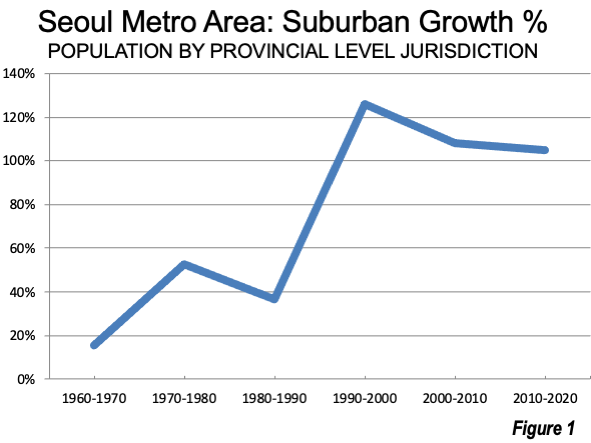
Seoul Suburbs: Dominating Metro Seoul and Korea Population Growth
The suburban province of Gyeonggi dominated population growth over that period, more than doubling from 6.1 million in 1990 to 13.5 million in 2020. Gyeonggi is now the largest provincial jurisdiction in the metropolitan area and has more than one-half the population.In the other suburban jurisdiction, the city of Incheon added as much population as the city Seoul lost, rising 1.1 million, from 1.8 million in 1990 to 2.9 million in 2020 (Figure 2). Incheon had been a part of Gyeonggi until the 1980s, and is the home to highly rated (and offshore) Incheon International Airport, the largest in Korea. The population trends in the three metropolitan area jurisdictions are illustrated in Figure 3.
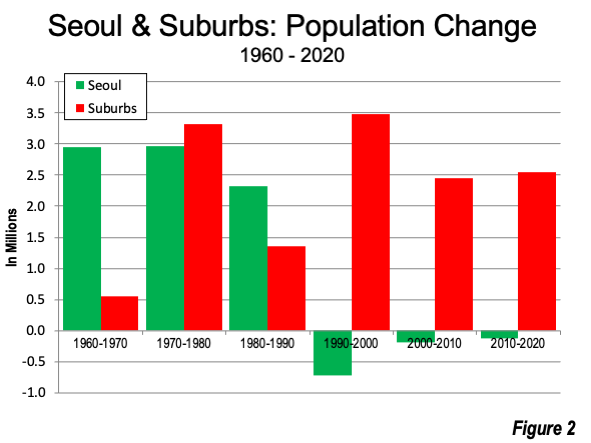
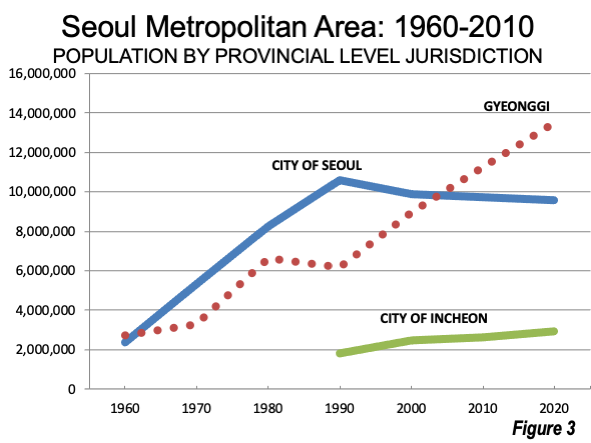
The rest of the nation grew little. Korea’s total population growth in the last 10 years was 2,489,000 while the Seoul metropolitan area grew 2,427,000. Korea outside the Seoul metro gained only 67,000 residents. Metro Seoul attracted 97.5% of the population growth, the rest of Korea only 2.5%.
But in reality it was the suburbs of Seoul, which experienced not only all of the Seoul metro growth over the last 30 years, but also all of the nation’s growth as well. Between 1990 and 2020, the suburbs gained 8.5 million new residents, while the rest of the nation (the city of Seoul and all areas outside the Seoul metropolitan area) lost 825,000 residents (Figure 4).
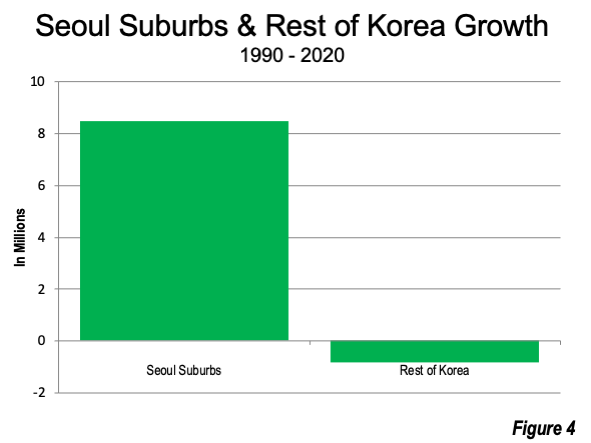
Highly urbanized and concentrated countries like Korea tend to also have low birthrates. For example, total fertility rates in suburban Seoul are lower the rest of the nation, except for the city of Seoul. A well below replacement total fertility rate dominates all of South Korea’s provinces (Figure 5). Moreover, far slower growing provinces outside metro Seoul have generally higher total fertility rates. The City of Seoul has a total fertility rate of 0.64. ranking 17thand last among provincial equivalents in the nation. The suburban rates are also low, with Gyeonggi 11th at 0.88 and Incheon 12th at 0.83 (Figure 5).
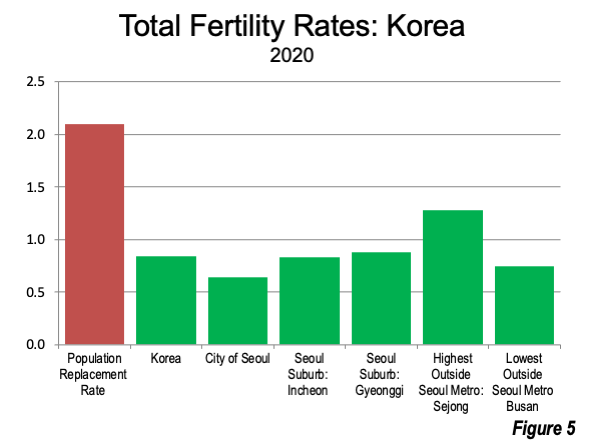
The Key to Seoul Suburban Growth: Internal Migration Gains
The key to suburban Seoul’s growth has been almost entirely net internal migration gains. For example, between 2010 and 2021, the suburbs of Seoul gained 1.3 million net domestic migrants, while the city of Seoul and the rest of Korea lost 1.3 million. Thus all of the net internal migration was to suburban Seoul (Figure 6).
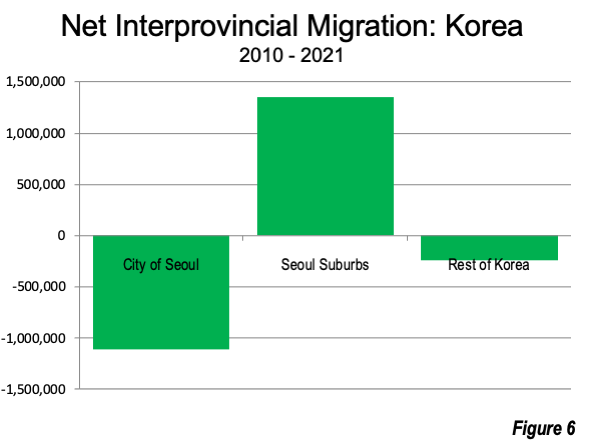
Korea: Moving to the Seoul Suburbs
Metro Seoul has a population greater than the rest of the nation (51%). This is level of concentration (Figure 7) more than that of any nation with more than 20 million residents (all of these nations have a population at least as great as metro New York). Concern about this centralization and the crowding of Seoul has led to designation of a new administrative capital in Sejong, which is more centrally located. The transition began in 2012, though it is unclear whether all of the government will ever move. The construction and movement of functions to Sejong has already spurred local economic development.
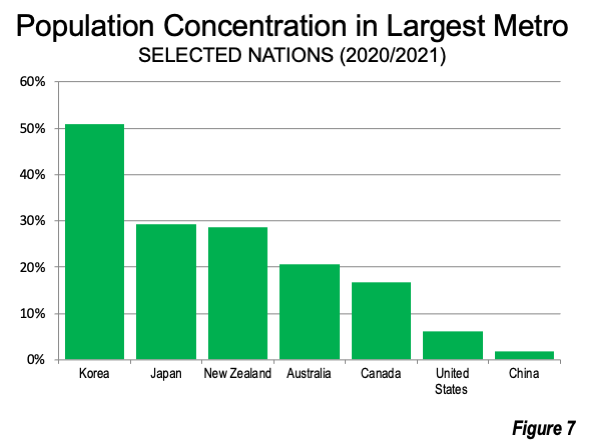
However, as with Brasilia, this seems to me unlikely to reduce the crowding in Seoul any more than has occurred in Rio de Janeiro, which since it lost the capital has become a megacity and added more than twice the population that lives in Brasilia. The Seoul suburbs seem likely to continue their growth even after the national population begins to decline, which according to Statistics Korea, is imminent.
However, eventually all of Korea is likely to fall into decline, including the Seoul suburbs. Reversing this national trend would require an unprecedented recovery in birth rates or a surge of immigration, which would also be unprecedented.
Wendell Cox is principal of Demographia, an international public policy firm located in the St. Louis metropolitan area. He is a founding senior fellow at the Urban Reform Institute, Houston, a Senior Fellow with the Frontier Centre for Public Policy in Winnipeg and a member of the Advisory Board of the Center for Demographics and Policy at Chapman University in Orange, California. He has served as a visiting professor at the Conservatoire National des Arts et Metiers in Paris. His principal interests are economics, poverty alleviation, demographics, urban policy and transport. He is co-author of the annual Demographia International Housing Affordability Survey and author of Demographia World Urban Areas.
Mayor Tom Bradley appointed him to three terms on the Los Angeles County Transportation Commission (1977-1985) and Speaker of the House Newt Gingrich appointed him to the Amtrak Reform Council, to complete the unexpired term of New Jersey Governor Christine Todd Whitman (1999-2002). He is author of War on the Dream: How Anti-Sprawl Policy Threatens the Quality of Life and Toward More Prosperous Cities: A Framing Essay on Urban Areas, Transport, Planning and the Dimensions of Sustainability.
Photo: Anyang, Gyeonggi (suburban Seoul) by Hyungyong Kim via
Wikimedia; use here under CC 2.0 License.













to the south...
Already there must be visible depopulation of the Korean countryside, akin to what has been more illustrated in Japan.